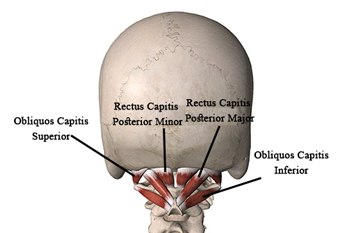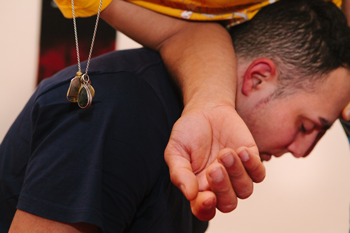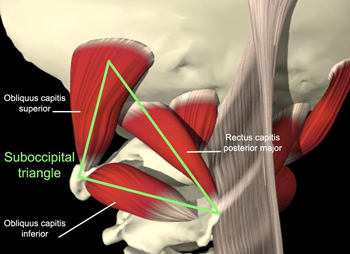Firstly the Cervical Occipital muscles are a group of muscles, that seat inferior to the skull and are bilateral to the first and second cervical vertebrae.
Cervical Occipital muscles are responsible for 45° of rotation out of 90°.
Along with these muscles we find:

– Obliquus Capitis Inferior;
Origin: Spinous process of Axis (C2)
Insertion: Transverse process of Atlas (C1)
Innervation: Suboccipital nerve
– Obliquus Capitis Superior
Origin: Transverse process of Atlas (C1)
Insertion: Superior line of Occipital bone
Innervation: Suboccipital nerve
– Rectus Capitis Posterior Major
Origin: Spinous process of Axis (C2)
Insertion: Inferior line of Occipital bone
Innervation: Suboccipital nerve (posterior ramus of spinal nerve C1)
– Rectus Capitis Posterior Minor
Origin: Spinous process of Atlas
Insertion: Inferior Line of Occipital bone
Innervation: Suboccipital nerve
The actions supported by Occipital Muscles are to extend and rotate the head.
How tight Occipital Muscle affect ROM.

When rotating the head, so looking at your right or left, you may notice that you don’t have a full range of 80° to 90°, and you start rotating with the thoracic too.
One possible reason for this is tension at the occipital area, due to muscle tension and or facet joint irritation.
Moreover, to the rotation and extension actions the Cervical Occipital Muscles, are responsible for holding the head up straight.
This characteristic is to be taken into consideration with the anti-gravity functionality.
In addition to the Cervical Occipital Muscles, other anti-gravitational muscles are the Soleus, Quadriceps Femoris Group, Gluteus Max, and Erectors Spines group.
The anti-gravity functionality is essential for the body to fight back gravity (9.81 m/sec2) and allows the body to stand straight up. This group of muscles received information in regard to the gravity pressure from the feet.
This information travels along the nervous system starting from the Center of Gravity (COG) of the feet.
If the COG is not balanced all body gets affected with a loss of balance as per result.
Furthermore, in modern days, the Cervical Occipital Muscles are under constant stress as per all the other anti-gravitas muscles.
This is due to spending long hours standing or seating.
For example, standing for long hours would overload the feet, leg and back muscles, whereas seating would inhibit the leg muscle but overload the back and cervical muscles.
On top of that, spending long hours looking at the phone and or PC would additionally put stress the Cervical Occipital Muscles muscles, as they get over-stretched.
How massage can help?
As per massaging this area, as therapists, we look into avoiding the Suboccipital triangle, which is defined by the border of the OCI, OCS, and the RCMaj.
The Suboccipital triangle is an endangerment site. This means contains superficial, delicate structures that are relatively unprotected and therefore prone to injuries, such as the Vertebral artery, Suboccipital nerve (C1) and Suboccipital venous plexus.
If this post is talking to you, and you are in need of a massage, book your next session by clicking here.
And what about exercises?
As per all the muscles of the body, there are exercises that can be done for the Cervical Occipital Muscles.
Along with Thai Yoga, I teach a really simple exercise that recalls the Scap Off Load Test ( a Functional test used to determine what muscle of the cervical region may affect the head rotation).
Firstly, in this exercise, available in the Melbourne Massage and Treatment YouTube playlist, you are seating on the floor with a cross leg (a yoga block or pillow can be used as per support), hands projected backwards, with wrists seated below shoulders on a straight line.
As per result, the neck would seat in between the shoulders.
Secondly, by flexing the head forward, reach the manubrium (the bond that connects the clavicles) with the chin, and with a gentle rotation movement, start rotating the head in a circular movement.
Indeed per many Thai Yoga exercises, it is important to be aware of the movement, the body sensation and the speed of movement, which is to be slow and weighted out.
